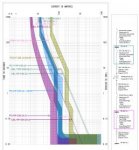lielec11
Senior Member
- Location
- Charlotte, NC
- Occupation
- Electrical Engineer (PE)
In the attached image I have a TCC showing a simple 208V-480V step up transformer arrangement. There is a fuse on the primary side (brown) and a fuse (green) as well as an MCB (blue) on the secondary side. My question is, do you need to worry about the MCB on the secondary side overlapping with the primary side fuse (blue over brown curve)? Or will this not be an issue in the field due to the transformer isolating the fault currents?




